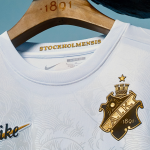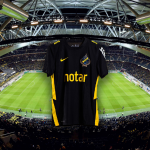
Inside the Stockholm Derby in analog
The clash between AIK and Djurgården transcends the competition on the field, embodying the essence of Swedish culture
April 26th, 2024
Oliver Dahle
Last weekend witnessed some of the most intriguing football games of the season. In Madrid, Real Madrid now clings to the LaLiga title after their victory over FC Barcelona in El Clásico. The following day, Inter Milan secured Lo Scudetto and their second star by defeating AC Milan at San Siro in the Derby della Madonnina. In the peripheral outskirts of European top football, there was one derby that didn't receive the same amount of spotlight — Tvillingderbyt (the Twin Derby). This derby is between the two Stockholm rivals, AIK and Djurgårdens IF, and has roots dating back to 1891. Founded only three weeks apart, this rivalry has its origins in historical contexts and sociological factors — Djurgården has historically been seen as an upper-middle-class club, a theme often reflected in chants. In terms of results, both clubs boast a similar amount of silverware. AIK has won the championship 12 times and the domestic cup eight times, while Djurgården has the same number of league titles but holds five cup titles. What sets this derby apart is the disparity between the quality on the field and the support coming from the stands.
The domestic league, Allsvenskan, is currently ranked 24th in Europe, and it's unusual for Swedish teams to reach the group stages of European competitions. When talents are rising in the teams, they are quickly sold to bigger teams. In Djurgården, the wunderkind, Lucas Bergvall, was sold to Tottenham Hotspurs for about 10 million euros this winter. Despite the on-field quality, the terraces play a significant role in proving why Sweden should be taken seriously. There is a burgeoning ultras scene, with choreographies that are doing the rounds globally on the internet, and attendance figures that rival those of top European leagues. In Sweden, clubs are governed by a 51% rule, which mandates that a majority stake of the club's ownership must be held by its members, i.e., the supporters. It's the only top league in Europe with a formal stance against VAR due to active resistance from supporters and a democratic process. One could argue that Swedish football belongs to its supporters. In a sold-out Friends Arena — Sweden's national stadium — nearly 45,000 attendees had gathered to watch the first league derby of the season. The two teams had clashed in the cup semifinal about a month ago, a nerve-wracking event that Djurgården won on penalties. AIK was now seeking revenge.
With falling snow as a backdrop and temperatures at only 2 degrees, the introductions featuring choreographies and pyrotechnic displays from both ends heated the atmosphere. The ultra and fan culture in Sweden has come under scrutiny from authorities and the police in recent years, who have attempted to control it in various ways. During the derby, banners from both ends expressed disbelief towards the police, VAR, and the Football Association. The second half began with another pyrotechnic display from AIK, accompanied by banners proclaiming "Här är Allsvenskan. Här är kulturen." (Here is Allsvenskan. Here is the culture.). The tifo did not necessarily celebrate their team but rather the uniqueness and eccentricity surrounding the league. In the second half, AIK took the lead with a screamer from 30 meters and later scored their second goal on the counterattack while Djurgården was attempting to equalize. With a 2-0 scoreline, AIK celebrated with the fans, who could now claim dominance over Stockholm. At least for this time.

































